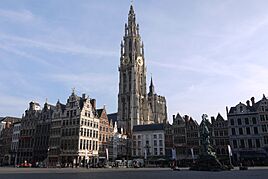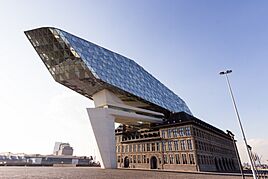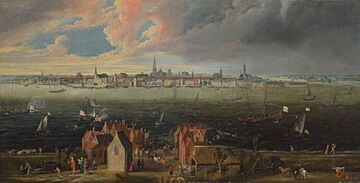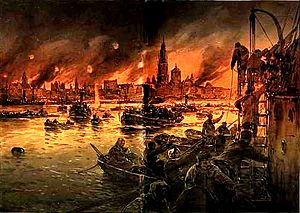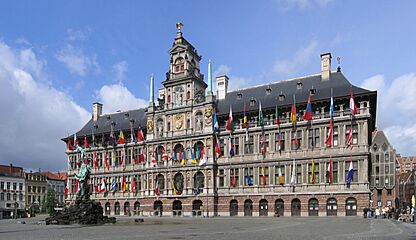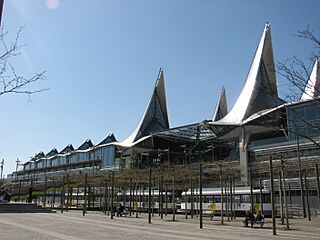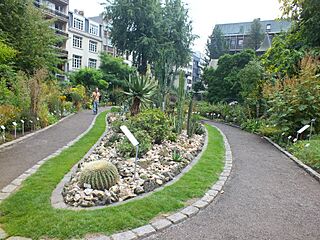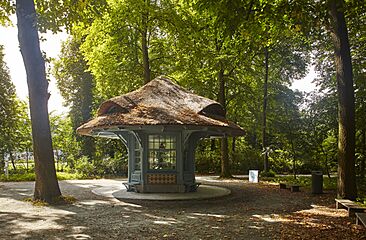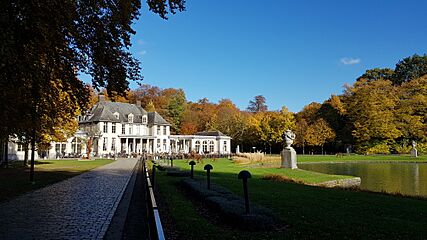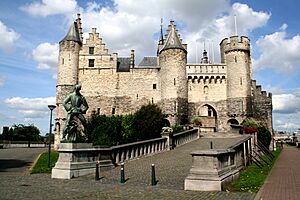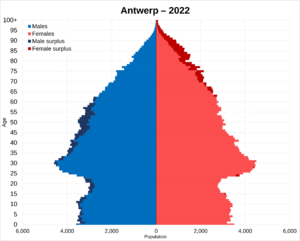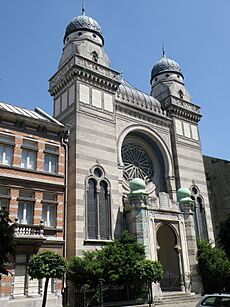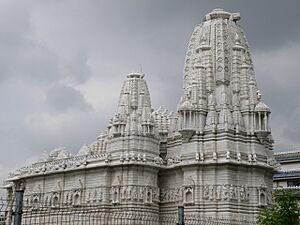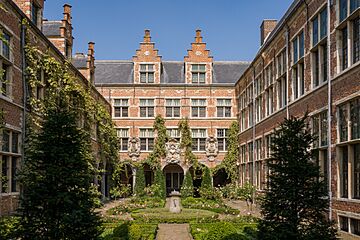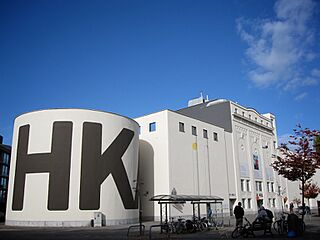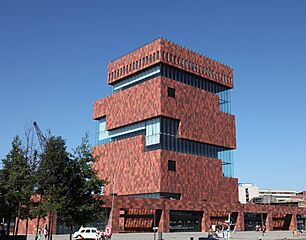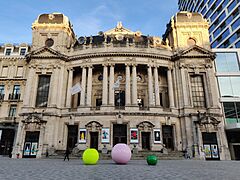Antwerp facts for kids
Quick facts for kids
Antwerp
Antwerpen (Dutch)
Anvers (French)
|
|||||
|---|---|---|---|---|---|
|
City and municipality
|
|||||
|
Cathedral of Our Lady
Museum aan de Stroom
Antwerp Central Station
Port Authority Building
|
|||||
|
|||||
| Nicknames:
Sinjoren and Pagadders
|
|||||
| Motto(s):
Atypisch Antwerpen (Atypical Antwerp)
|
|||||
| Country | |||||
| Region | Flanders | ||||
| Province | Antwerp | ||||
| Boroughs |
Nine districts
|
||||
| Area | |||||
| • Municipality | 204.32 km2 (78.89 sq mi) | ||||
| Elevation | 8 m (26 ft) | ||||
| Population
(2023-01-01)
|
|||||
| • Municipality | 536,079 | ||||
| • Density | 2,600/km2 (7,000/sq mi) | ||||
| • Metro | 1,230,000 | ||||
| Time zone | UTC+1 (CET) | ||||
| • Summer (DST) | UTC+2 (CEST) | ||||
| Postcode |
2000–2660
|
||||
| Area code | 03 | ||||
Antwerp is a major city and municipality in the Flemish Region of Belgium. It is the capital and largest city of Antwerp Province. It is also the third largest city in Belgium by land area, covering about 204.51 square kilometers. With over 536,000 people living there, it is the most populated municipality in Belgium. If you count the wider metropolitan area, it's the country's second-largest, with more than 1.2 million people.
The Scheldt river flows through Antwerp, connecting it to the North Sea. The city is about 40 kilometers north of Brussels and 15 kilometers south of the Dutch border. The Port of Antwerp is one of the biggest ports in the world, ranking second in Europe after Rotterdam. Antwerp is also known as a global center for the diamond trade. In 2020, it was recognized as an important Global City.
Antwerp has been a very important city in the Low Countries for a long time, both economically and culturally. In 1920, the city hosted the Summer Olympics.
The people of Antwerp are called Sinjoren. This nickname comes from the Spanish word señor, meaning "lord." It refers to the Spanish noblemen who ruled the city in the 17th century. Antwerp is a very diverse city, with people from about 180 different countries. A well-known group is the Jewish community, as Antwerp is one of the few cities in Europe with a large Haredi population today.
Contents
- About Antwerp's Name
- Antwerp Through Time
- Parts of Antwerp
- Neighborhoods of Antwerp
- Buildings and Design
- Green Spaces and Fun Areas
- Antwerp's Weather
- City Defenses
- People of Antwerp
- Antwerp's Economy
- Getting Around Antwerp
- Antwerp's Culture
- Sports in Antwerp
- Learning in Antwerp
- International Connections
- Images for kids
- See Also
About Antwerp's Name
Where the Name Comes From
The name Antwerp has been recorded in different ways over time. Some old Roman coins found in the city show Ando Verpia. Around 700 CE, it was called Andoverpis. The Latin form is Antverpia.
One idea is that the name comes from old Germanic words. Anda means "against," and werpen means "to throw." This could describe land thrown up at the riverbank, like a mound built for defense.
There's also a fun folklore story about the name. It says Antwerpen comes from the Dutch word handwerpen, meaning "hand-throwing." A giant named Antigoon supposedly lived by the Scheldt river. He would cut off the hand of any boatman who didn't pay his toll and throw it into the river. A young hero named Silvius Brabo eventually killed the giant, cut off his hand, and threw it into the river. This story is probably not true, but it's celebrated with a statue in the city's main market square, the Grote Markt.
Antwerp Through Time
Early History (Before 1500)
Antwerp started as a small Roman settlement. Digs have found pottery and glass from the 2nd and 3rd centuries. In the 4th century, Germanic Franks settled here, and the city was first named.
In the 7th century, Saint Amand brought Christianity to Antwerp. Het Steen Castle, the city's oldest building, dates back to the 9th century. It might have been built after Viking attacks. The castle you see today was built between 1200 and 1225. By the end of the 10th century, the Scheldt river became a border, and Antwerp became an important border area.
The Golden Age (16th Century)
After the city of Bruges declined, Antwerp grew very quickly. Its population doubled between 1500 and 1569. Trading companies moved from Bruges to Antwerp. New sea routes to Asia and America made Antwerp even more important.
By 1504, the Portuguese used Antwerp as a main shipping base, bringing spices from Asia. The city traded cloth from England, wines, salt, and wheat. Skilled workers processed soap, fish, sugar, and cloth. Banks helped fund all this trade. The city was a global hub; its stock exchange, the Bourse at Antwerp, opened in 1531 for "merchants of all nations."
Antwerp became Europe's sugar capital. It imported raw sugar and refined it, sending it to places like Germany. The city also had many painters, about 360 in 1560, making it a major art center. Moneylenders in Antwerp lent money across Europe. Fernand Braudel, a historian, said Antwerp became the center of the entire international economy. It was the richest city in Europe at the time.
However, after the 1570s, Antwerp's economy started to decline. The Portuguese merchants left, and there was less trade in English cloth. Many businesses went bankrupt. Amsterdam then became the main trading center in the region.
Religious Changes and Conflict
In August 1566, the Reformation led to violent riots in Antwerp. When the Dutch revolt against Spain began in 1568, trade between Antwerp and Spain stopped. On November 4, 1576, Spanish soldiers attacked the city in what was called the Spanish Fury. About 8,000 citizens were killed, and many buildings were burned.

The city joined the Dutch Revolt in 1579. But in 1585, Alessandro Farnese captured Antwerp after a long siege. As part of the surrender, Protestant citizens had two years to leave the city. Most moved north to the United Provinces, which helped start the Dutch Golden Age there.
Later Centuries (17th–19th)
In 1648, a peace treaty closed the Scheldt river to shipping, which greatly hurt Antwerp's trade. This closure lasted until 1863. By 1800, Antwerp's population had dropped to under 40,000.
Napoleon saw how important Antwerp's port could be. He provided money to make the harbor bigger and deeper so larger ships could use it. He hoped this would help Antwerp compete with the Port of London. However, he was defeated at the Battle of Waterloo before his plans were finished.
In 1830, Belgian rebels captured the city. But a Dutch army held the citadel and bombed the town. In 1832, French forces besieged the citadel, causing more damage. The Dutch commander eventually surrendered.
Later in the 19th century, a double ring of forts was built around Antwerp to protect the young Belgian state. In 1894, Antwerp hosted a World's Fair that attracted 3 million visitors.
Modern Times (20th Century)
Antwerp hosted the first World Gymnastics Championships in 1903. During World War I, the city was attacked by the German Army in 1914 and remained under German control until the war ended. A few years later, Antwerp hosted the 1920 Summer Olympics.
During World War II, Antwerp's port was a key target. The city was occupied by Germany in 1940 and freed by the British in 1944. After its liberation, the Germans tried to destroy the port using thousands of V-1 and V-2 rockets. These rockets caused a lot of damage to the city but did not destroy the port. After the war, Antwerp's Jewish population grew again, especially the Haredi community.
In the 1950s and 60s, a Ten-Year Plan modernized the port. This helped new industries grow in the area. Starting in the 1990s, Antwerp became known as a world-class fashion center, competing with cities like London and Paris.
Parts of Antwerp
The city of Antwerp is divided into nine main areas called districts.
| # | name | surface
(km2) |
inhabitants | population density | population density
in residential areas |
Flag |
|---|---|---|---|---|---|---|
| 1 | Antwerp | 83,18 | 198,784 | 2,390 | 11,959 | |
| 2 | Berchem | 5,70 | 43,325 | 7,603 | 10,717 | |
| 3 | Berendrecht-Zandvliet-Lillo | 52,43 | 9,962 | 190 | 3,315 | |
| 4 | Borgerhout | 3,90 | 46,424 | 11,904 | 17,026 | |
| 5 | Deurne | 13,03 | 82,270 | 6,315 | 11,932 | |
| 6 | Ekeren | 13,48 | 28,720 | 2,131 | 4,614 | |
| 7 | Hoboken | 10,52 | 41,352 | 3,932 | 8,451 | |
| 8 | Merksem | 8,42 | 45,929 | 5,457 | 10,691 | |
| 9 | Wilrijk | 13,71 | 41,916 | 3,057 | 7,026 |
In 1958, some towns like Berendrecht-Zandvliet-Lillo became part of Antwerp city. In 1983, more towns merged into the city, and that's when the current districts were created. The old town halls became district halls.
The nearby town of Borsbeek might become the tenth district of Antwerp in the future.
Neighborhoods of Antwerp
The city of Antwerp has many different neighborhoods. Some of them are known by their postal codes.
The Inner City - 2000
This is the historical heart of Antwerp, located between the river and old Spanish walls. The Spanish walls are now a wide avenue called de Leien. Famous sights like the Cathedral are here.
Some neighborhoods in the inner city are:
- Historical centre
- Meir
- Schipperskwartier
- Quartier Latin
- University quarter
- het Zuid
- nieuw Zuid
- het Eilandje
Antwerpen-Noord - 2060
Antwerpen-Noord (Antwerp North) is a busy and very diverse part of the city.
- Seefhoek
- Stuivenberg
- Amandus-Atheneum
- Dam
Antwerpen intra-muros - 2018
This postal code covers areas between de Leien and the city's ring road.
- Statiekwartier
- Diamond square
- Groen Kwartier
- Haringrode
- Zurenborg
- Brederode
- Klein-Antwerpen
- Kievit quarter
- Harmonie
Antwerpen extra-muros - 2020
- Kiel
- Tentoonstellingswijk
- Middelheim (this area is partly in the Wilrijk district)
Antwerpen 2030
- Luchtbal
- A large part of this area is industrial port land, not residential.
Linkeroever - 2050
Linkeroever, meaning "Left bank," joined the city in 1923. It used to be farmland.
Berchem - 2600
Antwerp-Berchem is a lively district with a rich history, busy streets, and a major transport hub.
Buildings and Design
Antwerp's buildings show a mix of old and new styles, from Gothic and Renaissance to modern designs. In the 16th century, the city was known for its wealthy citizens. Their beautiful houses are still seen today. However, fires and bombs during World War II damaged many old buildings.
Here are some famous examples of Antwerp's architecture:
- The Port House: A modern building designed by Zaha Hadid. It combines an old building with a new, futuristic glass section.
- The Provincial Government Building: A unique triangular building with natural stone, designed by Xaveer De Geyter Architects.
- De Singel: A cultural center with a modern design, using glass and concrete.
- The Palace of Justice: A modern building by Richard Rogers with a large dome, made mostly of glass and steel.
- MAS Museum: A modern building with a distinct red stone outside, exploring Antwerp's history with the sea.
- Zurenborg neighborhood: Famous for its Art Nouveau buildings, with detailed designs, colorful mosaics, and stained glass.
- Maison Guiette: A house designed by Le Corbusier in 1926-1927. It's a UNESCO World Heritage Site and an important example of modern architecture.
- De Boerentoren: Also called "The Farmer's Tower," this historic Art Deco skyscraper was once the tallest building in Europe.
- The Bourla Theatre: A historic theater from the 19th century, built in the Neo-Classical style.
- The Hendrik Conscience Heritage Library: One of Belgium's oldest and largest libraries, started in 1481. It holds over 1.5 million books and documents about Flanders' history.
- The Royal Museum of Fine Arts: A Neo-Classical building with a huge collection of Flemish art from the 14th to 20th centuries.
- Antwerp Central Station: A beautiful train station known for its impressive Beaux-Arts style.
- The Sint-Annatunnel (Pedestrian Tunnel): A 572-meter-long tunnel opened in 1933. It connects the city center with the Left Bank under the Scheldt River. It has an Art Deco design and unique wooden escalators.
- Nieuw Zuid (New South) neighborhood: A new, green neighborhood being built by the river. It will feature buildings by famous international architects.
Antwerp also has many historic Gothic, Baroque, and Renaissance buildings. These include the Antwerp City Hall, the Cathedral of Our Lady, the St. James' Church, the Vleeshuis Museum, and the St. Charles Borromeo Church.
Green Spaces and Fun Areas
Antwerp has many parks and fun places to visit.
One of the most popular is the Antwerp Zoo. It opened on July 21, 1843, making it one of the oldest zoos in the world. The zoo covers 10 hectares and is home to over 5,000 animals from more than 950 species. It's right next to Antwerp Central Station. Antwerp Zoo helps protect endangered animals through special breeding programs. The entire park is a protected monument.
Other well-known parks include:
- Nachtegalen Park: A large area with several parks south of Antwerp, totaling 90 hectares. These parks, like Den Brandt and Vogelenzang, were built around castles.
- Middelheim Park: Part of Nachtegalen Park, this park is famous for its outdoor sculpture museum with over 400 artworks. It also hosts concerts and festivals.
- The Rivierenhof: A huge public park in the Deurne district, covering 130 hectares. It has beautiful gardens, lakes, and walking paths. It was designed in the 1920s as a park for everyone.
- Park Spoor Noord: A large urban park in northern Antwerp, built on an old railway yard. It has playgrounds, sports fields, a skate park, and restaurants.
- The Stadspark: A public park in the center of Antwerp, opened in 1869. It covers about 14 hectares.
- The Botanic Garden: A popular place with many exotic plants and flowers from around the world.
- The Boekenbergpark: A park in Deurne known for its unique outdoor swimming pool filled with filtered rainwater. It's an eco-friendly park with walking paths and playgrounds.
- Te Boelaerpark: A public park in Borgerhout, covering 8.2 hectares, popular for recreation.
- Hobokense Polder: A nature reserve in the Hoboken district, about 170 hectares of meadows, wetlands, and forests.
Antwerp's Weather
Antwerp has an oceanic climate, meaning it has cool winters, warm summers, and often light rain throughout the year. Because of the Gulf Stream, the weather is generally mild. The average temperature changes between 4°C (39°F) and 19°C (66°F) during the year.
| Climate data for Antwerp (1991−2020 normals, extremes 1949−present) | |||||||||||||
|---|---|---|---|---|---|---|---|---|---|---|---|---|---|
| Month | Jan | Feb | Mar | Apr | May | Jun | Jul | Aug | Sep | Oct | Nov | Dec | Year |
| Record high °C (°F) | 15.6 (60.1) |
19.3 (66.7) |
24.6 (76.3) |
28.7 (83.7) |
32.9 (91.2) |
34.5 (94.1) |
40.4 (104.7) |
36.1 (97.0) |
35.0 (95.0) |
26.2 (79.2) |
20.3 (68.5) |
17.2 (63.0) |
40.4 (104.7) |
| Mean daily maximum °C (°F) | 6.8 (44.2) |
7.7 (45.9) |
11.2 (52.2) |
15.3 (59.5) |
18.9 (66.0) |
21.6 (70.9) |
23.6 (74.5) |
23.6 (74.5) |
20.1 (68.2) |
15.4 (59.7) |
10.5 (50.9) |
7.2 (45.0) |
15.2 (59.4) |
| Daily mean °C (°F) | 4.0 (39.2) |
4.4 (39.9) |
7.1 (44.8) |
10.3 (50.5) |
14.0 (57.2) |
16.9 (62.4) |
18.9 (66.0) |
18.6 (65.5) |
15.5 (59.9) |
11.5 (52.7) |
7.4 (45.3) |
4.6 (40.3) |
11.1 (52.0) |
| Mean daily minimum °C (°F) | 1.3 (34.3) |
1.2 (34.2) |
3.0 (37.4) |
5.2 (41.4) |
9.1 (48.4) |
12.2 (54.0) |
14.2 (57.6) |
13.7 (56.7) |
10.8 (51.4) |
7.6 (45.7) |
4.4 (39.9) |
2.0 (35.6) |
7.1 (44.8) |
| Record low °C (°F) | −18.5 (−1.3) |
−18.1 (−0.6) |
−10.8 (12.6) |
−4.9 (23.2) |
−2.6 (27.3) |
1.7 (35.1) |
5.0 (41.0) |
4.6 (40.3) |
1.1 (34.0) |
−6.1 (21.0) |
−9.5 (14.9) |
−16.1 (3.0) |
−18.5 (−1.3) |
| Average precipitation mm (inches) | 70.0 (2.76) |
62.8 (2.47) |
54.2 (2.13) |
43.1 (1.70) |
59.8 (2.35) |
76.9 (3.03) |
82.3 (3.24) |
84.0 (3.31) |
75.6 (2.98) |
72.6 (2.86) |
80.7 (3.18) |
90.9 (3.58) |
852.9 (33.58) |
| Average precipitation days (≥ 1.0 mm) | 12.6 | 11.6 | 10.5 | 8.8 | 9.8 | 10.2 | 10.5 | 10.8 | 10.1 | 11.1 | 12.9 | 14.1 | 132.8 |
| Mean monthly sunshine hours | 62 | 78 | 136 | 192 | 221 | 220 | 225 | 212 | 164 | 117 | 66 | 51 | 1,743 |
| Source 1: Royal Meteorological Institute | |||||||||||||
| Source 2: Temperature estreme in Toscoma (extremes) | |||||||||||||
City Defenses
Antwerp used to be a heavily fortified city, but most of its old walls are gone. You can still see some parts of the city wall near the Vleeshuis museum. Steen castle on the Scheldt river is the gate of a larger castle that was torn down. It was partly rebuilt in the 19th century.
Antwerp's defenses were built in different stages:
- 10th century: A wall and ditch were built around the wharf.
- 12th and 13th century: Canals were created.
- 16th century: Spanish fortifications were added.
- 19th century: A double ring of forts was built around the city.
- 20th century: The inner ring of forts was removed, and the outer forts were no longer used for defense.
People of Antwerp
Population Over Time
Here's how the population of Antwerp city (not the whole municipality) has changed:
|
|
Different Backgrounds and Religions
Antwerp is a very diverse city. In 2010, about 36% to 39% of people in Antwerp had foreign backgrounds. By 2023, about 56% of the population had a foreign background, either first, second, or third generation.
| Country of origin | Population |
|---|---|
| 76,593 | |
| 28,582 | |
| 25,419 | |
| 12,430 | |
| 9,644 | |
| 6,841 | |
| 6,229 | |
| 6,223 | |
| 4,915 | |
| 4,862 |
| Group of origin | Year | |||||||||
|---|---|---|---|---|---|---|---|---|---|---|
| 2001 | 2006 | 2011 | 2016 | 2023 | ||||||
| Number | % | Number | % | Number | % | Number | % | Number | % | |
| Belgians with Belgian background | 340,130 | 76.3% | 316,993 | 68.7% | 291,499 | 59.1% | 268,317 | 51.9% | 235,374 | 43.7% |
| Belgians with foreign background | 50,378 | 11.3% | 85,171 | 18.5% | 115,236 | 23.3% | 143,009 | 27.6% | 178,476 | 33.1% |
| Neighboring country | 10,344 | 2.3% | 11,911 | 13,387 | 14,820 | 17,132 | 3.2% | |||
| EU27 (excluding neighboring country) | 5,179 | 1.2% | 6,328 | 7,518 | 9,181 | 12,514 | 2.3% | |||
| Outside EU 27 | 34,855 | 7.8% | 66,932 | 94,331 | 119,008 | 148,830 | 27.6% | |||
| Non-Belgians | 55,062 | 12.3% | 59,332 | 12.9% | 86,782 | 17.6% | 105,716 | 20.4% | 125,060 | 23.2% |
| Neighboring country | 11,515 | 2.6% | 13,385 | 18,810 | 22,588 | 23,253 | 4.3% | |||
| EU27 (excluding neighboring country) | 7,130 | 1.6% | 9,215 | 18,557 | 28,197 | 33,109 | 6.1% | |||
| Outside EU 27 | 36,417 | 8.2% | 36,732 | 49,415 | 54,931 | 68,698 | 12.7% | |||
| Total | 445,570 | 100% | 461,496 | 100% | 493,517 | 100% | 517,042 | 100% | 538,910 | 100% |
Jewish Community
Antwerp has a large Jewish community, especially a group called Haredi (a type of Orthodox Judaism).
Jain Community
About 1,500 Jains live in Belgium, mostly in Antwerp. Many work in the diamond business. They have built a major temple and cultural center in Wilrijk, Antwerp.
Armenian Community
There are also many Armenian communities in Antwerp. Many are descendants of traders who came in the 19th century. Most Armenian Belgians belong to the Armenian Apostolic Church. Many Armenian families are involved in the diamond trade in the diamond district.
Antwerp's Economy
The Port
The Port of Antwerp is one of the world's largest ports. In 2005, it was the 17th biggest by cargo weight and second in Europe after Rotterdam. In 2018, it handled 235.2 million tons of cargo. The port handles many different types of goods, including general cargo and large project cargo.
Antwerp's port area has five oil refineries and many petrochemical industries. This makes it one of the largest petrochemical centers in the world. Electricity is also produced here, with four nuclear power plants nearby. There's also a wind farm in the northern part of the port.
Diamonds
Another very important part of Antwerp's economy is the diamond trade. Most of the world's rough diamonds pass through Antwerp's diamond district each year. In 2011, the industry made $56 billion.
Antwerp has four diamond bourses (trading centers). The city's history with diamonds goes back to the 16th century. After World War II, many families from the large Hasidic Jewish community became leaders in the diamond trade. In recent years, Indian and Maronite Christians from Lebanon, and Armenian traders have also become very important.
The Antwerp World Diamond Centre (AWDC) helps set standards and promotes Antwerp as the diamond capital.
Getting Around Antwerp
Trains
Antwerp is a major train hub. Lines go north to the Netherlands, east to Turnhout, south to Brussels, and southwest to Ghent. You can take international Thalys trains to Amsterdam, Rotterdam, and Paris. National trains connect Antwerp to many Belgian cities.
Antwerp Central Station is a beautiful building. It's a famous landmark. In 2007, a new tunnel was finished, allowing trains to pass through the station without reversing.
Antwerp is also home to Antwerpen-Noord, the largest train yard for cargo in Belgium. It's the second largest in Europe.
Local Public Transport
The city has a network of tram and bus lines run by De Lijn. These connect the city center, suburbs, and the Left Bank. The tram network has 14 lines, and part of it runs underground, called the "premetro." It even has a tunnel under the river. The Franklin Rooseveltplaats is the main hub for local and regional buses.
Roads
A six-lane motorway, known as the "Ring," goes around much of the city center. It connects Antwerp to motorways leading to Brussels, Ghent, and the Netherlands. Three road tunnels connect the banks of the Scheldt river: the Waasland Tunnel (1934), the Kennedy Tunnel (1967), and the Liefkenshoek Tunnel (1991).
Because of daily traffic jams, a new highway link called the "Oosterweelconnection" was planned. After public discussion, it was decided to build a series of tunnels instead of a bridge. There are also plans to cover the Ring motorway, like in other big cities. This would help connect the city with its suburbs and allow for new development.
Air Travel
A small airport, Antwerp International Airport, is in the district of Deurne. It's mainly used for business travel. TUI fly has regular flights to Spain, Croatia, Italy, Austria, and Morocco. From 2023, Luxair will fly to London City.
Belgium's main international airport, Brussels Airport, is about 45 kilometers from Antwerp. It connects Antwerp to the rest of the world. There's a direct fast train connection between Antwerp and Brussels Airport. There's also a direct train service to Charleroi South station, with a bus link to Brussels South Charleroi Airport.
Water Travel
Since 2017, a regular water ferry called DeWaterbus connects the city center with towns along the Scheldt river. It's popular with people commuting to the port and cyclists on day trips.
Antwerp's Culture
Antwerp was famous for its art in the 17th century, especially its school of painting. Famous artists like Rubens, Van Dyck, and Jordaens worked here.
Museums
- Royal Museum of Fine Arts: A beautiful building with paintings, sculptures, and drawings from the 14th to 20th centuries.
- Rubenshuis: The former home and studio of the famous painter Peter Paul Rubens. It's now a museum.
- Plantin-Moretus Museum: This museum preserves the house of printer Christoffel Plantijn. It's a UNESCO World Heritage Site.
- Museum Mayer van den Bergh: Features art from the Gothic and Renaissance periods, including paintings by Pieter Brueghel the Elder.
- Museum of Contemporary Art (M HKA): Has a collection of modern art, an art cinema, and a large library.
- Museum aan de Stroom: Focuses on Antwerp and its connections to the world.
- Fotomuseum Antwerp: Also known as FOMU, it's a museum dedicated to photography.
- MoMu ModeMuseum: A fashion museum that collects and displays Belgian fashion.
- Red Star Line Museum: Tells the story of the Red Star Line shipping company, which brought many immigrants to America.
Music and Festivals
Antwerp has the Antwerp Jazz Club (AJC), founded in 1938. There are also many concert halls, like the Stadsschouwburg, the Bourlaschouwburg, and the Flemish Opera. Large pop concerts are often held at the Sportpaleis or Lotto Arena.
Some popular festivals in and around the city include:
- Linkerwoofer: A pop-rock music festival on the left bank of the Scheldt.
- Jazz Middelheim: An annual summer jazz festival in Middelheim Park.
- Tomorrowland: A very famous electronic music festival, located just outside Antwerp in Boom.
- Sfinks: A global pop festival that takes place annually in Boechout, southeast of Antwerp.
- Other popular festivals are Fire Is Gold, Ampere Open Air, and Vaag Outdoor, which focus on hip-hop, house, and techno music.
Nightlife
Antwerp has a lively nightlife with many cafés and nightclubs. The old city center and Grote Markt have a cozy feel with many cafes, like the famous jazz café De Muze. Belgians are known for their beer, and visitors can try many local brews.
Other popular areas include het Mechelseplein and the busy Dageraadplaats in the Zurenborg neighborhood. The het Zuid district is also popular, with many bars, restaurants, and cafes near museums. Het Eilandje neighborhood also has many cafes and restaurants around the MAS Museum.
Fashion
Antwerp is a growing fashion city. It has produced famous designers like the Antwerp Six. The city is important in the fashion world because of the Royal Academy of Fine Arts, one of the top fashion schools globally. Many successful Belgian fashion designers, like Raf Simons, studied there.
Local Products
Antwerp is known for its local products. The Bollekesfeest, held every August, showcases local items like Bolleke, an amber beer from the De Koninck Brewery. Seefbier, an old Antwerp ale from the 16th century, is one of Belgium's oldest beer styles.
Other local specialties include Mokatine sweets, Elixir D'Anvers (a local liquor), Koffie Verheyen (locally roasted coffee), and Antwerpse Handjes (Antwerp Hands) biscuits. These biscuits, made from short pastry with almonds or milk chocolate, are a symbol of Antwerp.
Food and Restaurants
Antwerp has become a top place for food in Flanders and Belgium. It has many restaurants with MICHELIN stars. Zilte by Viki Geunes, located in the MAS museum, has even received three stars.
World Choir Games
Antwerp was a co-host for the 2021 World Choir Games with the city of Ghent. This is the biggest choir competition and festival in the world.
Sports in Antwerp
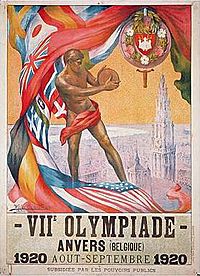
Events
Antwerp hosted the 1920 Summer Olympics, which were the first games after World War I. It was the only time the Olympics were held in Belgium. Antwerp also hosted the World Artistic Gymnastics Championships in 2013 and 2023 at the Sportpaleis. Each year, Antwerp hosts the European Open tennis tournament at the Sportpaleis. The city also holds the Antwerp 10 Miles race and the Antwerp Marathon every year.
In 2013, Antwerp was named the European Capital of Sport.
Football
Antwerp has two professional football clubs. Royal Antwerp F.C. was founded in 1880 and is known as 'The Great Old' because it was the first club registered in Belgium. They have won five Belgian league titles and four Belgian Cups.
Another club is K Beerschot VA, founded in 1899 by former Royal Antwerp players. They play at the Olympisch Stadion, which was the main venue for the 1920 Olympics. There is a big rivalry between these two teams, leading to exciting matches.
Basketball
The Antwerp Giants play in the BNXT League, which is the top basketball league in both the Netherlands and Belgium. Their home court is the Lotto Arena. Antwerp has won the Belgian championship once, in 2000, and the Belgian Cup five times.
In 2022, Antwerp's Groenplaats hosted the official FIBA 3x3 World Cup for basketball.
Learning in Antwerp
Antwerp has a university and several colleges. The University of Antwerp was created in 2003 by combining three older institutes. It has about 23,000 students, including 1,800 international students, making it the third-largest university in Flanders. It has 7 faculties across four campuses in the city.
The KU Leuven also has a campus in Antwerp. The city's colleges include Antwerp Management School (AMS), the Antwerp Maritime Academy, the Karel de Grote Hogeschool, and AP Hogeschool Antwerpen.
International Connections
Twin Cities
Antwerp is twinned with these cities around the world:
Sister Ports
Partnerships
Antwerp also works with these cities for development:
|
Images for kids
See Also
 In Spanish: Amberes para niños
In Spanish: Amberes para niños


